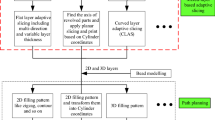Abstract
The purpose of this article is to introduce a nonplanar helical slicing method for additive manufacturing (AM) which forms a single continuous three-dimensional tool path and removes seam defects. In the proposed method, the geometry is initially sliced into planar slices. Afterwards, using two consecutive planar slices, direction vectors from the current layer to the next layer are constructed. These vectors are used to generate helical slices in-between planar slices. Repeating the process for all the planar slices results in a single helical sliced tool path. With the direction vectors, geometric improvements over the existing spiralization methods are obtained. With the helical slicing method, the seam defects which are found in the extrusion start–stop points of the planar slices are removed. The switching control of the extruder is simplified, and non-extrusion movements of the extruder are eliminated. The generated tool path is tested using a material extrusion-based robotic AM setup. Manufactured models are investigated in detail under the scanning electron microscope. The method is applicable for additively manufacturing complex freeform shell type, genus zero models with no infill and minor overhangs. This helical slicing method removes the form errors found in those of previously developed solutions.












Similar content being viewed by others
References
Gao W, Zhang Y, Ramanujan D et al (2015) The status, challenges, and future of additive manufacturing in engineering. Comput Des 69:65–89. https://doi.org/10.1016/j.cad.2015.04.001
Zhao G, Ma G, Feng J, Xiao W (2018) Nonplanar slicing and path generation methods for robotic additive manufacturing. Int J Adv Manuf Technol 1:11. https://doi.org/10.1007/s00170-018-1772-9
Tsao C, Chang H, Liu M et al (2018) Freeform additive manufacturing by vari-directional vari-dimensional material deposition. Rapid Prototyp J 24:379–394. https://doi.org/10.1108/RPJ-01-2017-0014
Ulu E, Korkmaz E, Yay K et al (2015) Enhancing the structural performance of additively manufactured objects through build orientation optimization. J Mech Des 137:111410
Thrimurthulu K, Pandey PM, Reddy NV, Venkata Reddy N (2004) Optimum part deposition orientation in fused deposition modeling. Int J Mach Tools Manuf 44:585–594. https://doi.org/10.1016/j.ijmachtools.2003.12.004
Pandey PM, Reddy NV, Dhande SG (2003) Real time adaptive slicing for fused deposition modelling. Int J Mach Tools Manuf 43:61–71. https://doi.org/10.1016/S0890-6955(02)0016-5
Tyberg J, Bøhn JH (1998) Local adaptive slicing. Rapid Prototyp J 4:118–127. https://doi.org/10.1108/13552549810222993
Pandey PM, Reddy NV, Dhande SG (2003) Slicing procedures in layered manufacturing: a review. Rapid Prototyp J 9:274–288. https://doi.org/10.1108/13552540310502185
Malhotra R (2016) Automatic 3D spiral toolpath generation for single point. J Manuf Sci Eng 132:1–10. https://doi.org/10.1115/1.4002544
Zhu H, Liu Z, Fu J (2011) Spiral tool-path generation with constant scallop height for sheet metal CNC incremental forming. Int J Adv Manuf Technol 54:911–919. https://doi.org/10.1007/s00170-010-2996-5
Lee E (2003) Contour offset approach to spiral toolpath generation with constant scallop height. Comput Des 35:511–518. https://doi.org/10.1016/S0010-4485(01)00185-3
Zhao H, Chen B, Gu F et al (2016) Connected fermat spirals for layered fabrication. ACM Trans Graph 35:1–10. https://doi.org/10.1145/2897824.2925958
Singh P, Dutta D (2008) Offset slices for multidirection layered deposition. J Manuf Sci Eng 130:011011. https://doi.org/10.1115/1.2783217
Ruan J, Eiamsa-ard K, Liou FW (2005) Automatic process planning and toolpath generation of a multiaxis hybrid manufacturing system. J Manuf Process 7:57–68. https://doi.org/10.1016/S1526-6125(05)70082-7
Ruan J, Eiamsa-ard K, Liou FW (2005) Automatic multi-axis slicing based on centroidal axis computation. In: 25th computers and information in engineering conference, parts A and B, volume 3. ASME, pp 383–393
Hildebrand K, Bickel B, Alexa M (2013) Orthogonal slicing for additive manufacturing. Comput Graph 37:669–675. https://doi.org/10.1016/j.cag.2013.05.011
Ruan J, Sparks TE, Panackal A et al (2007) Automated slicing for a multiaxis metal deposition system. J Manuf Sci Eng 129:303. https://doi.org/10.1115/1.2673492
Zhang J, Liou F (2004) Adaptive slicing for a multi-axis laser aided manufacturing process. J Mech Des 126:254. https://doi.org/10.1115/1.1649966
Allen RJA, Trask RS (2015) An experimental demonstration of effective curved layer fused filament fabrication utilising a parallel deposition robot. Addit Manuf 8:78–87. https://doi.org/10.1016/j.addma.2015.09.001
Llewellyn-Jones T, Allen R, Trask R (2016) Curved layer fused filament fabrication using automated toolpath generation. 3D Print Addit Manuf 3:3. https://doi.org/10.1089/3dp.2016.0033
Lim S, Buswell RA, Valentine PJ et al (2016) Modelling curved-layered printing paths for fabricating large-scale construction components. Addit Manuf 12:216–230. https://doi.org/10.1016/j.addma.2016.06.004
Huang B, Singamneni SB (2015) Curved layer adaptive slicing (CLAS) for fused deposition modelling. Rapid Prototyp J 21:354–367. https://doi.org/10.1108/RPJ-06-2013-0059
Hopkins PE, Holzwarth DJ (2009) Seam concealment for three-dimensional models. US Patent US8349239B2
Chavel I (1995) Riemannian geometry: a modern introduction. Cambridge University Press, Cambridge
Author information
Authors and Affiliations
Corresponding author
Ethics declarations
Conflict of interest
The authors declared that there is no conflict of interest.
Rights and permissions
About this article
Cite this article
Yigit, I.E., Lazoglu, I. Helical slicing method for material extrusion-based robotic additive manufacturing. Prog Addit Manuf 4, 225–232 (2019). https://doi.org/10.1007/s40964-019-00090-w
Received:
Accepted:
Published:
Issue Date:
DOI: https://doi.org/10.1007/s40964-019-00090-w




